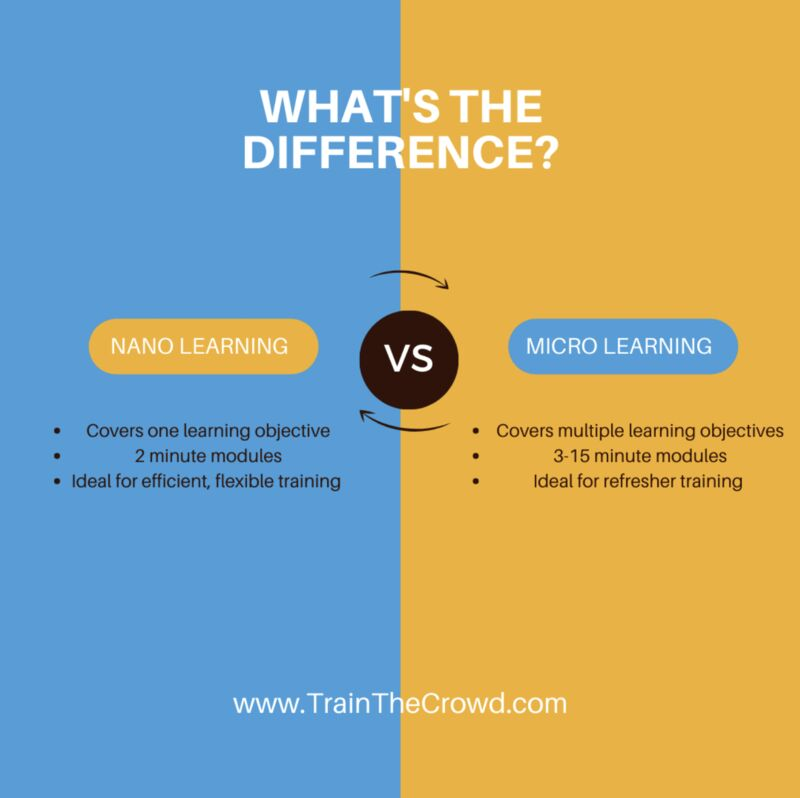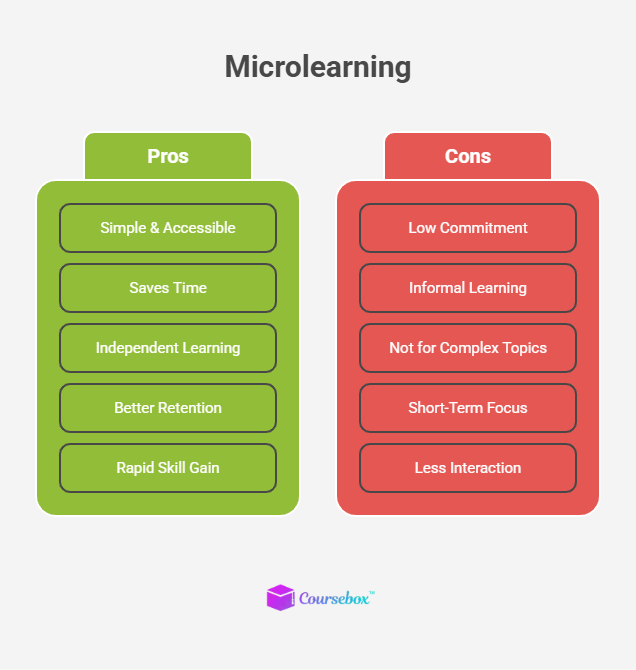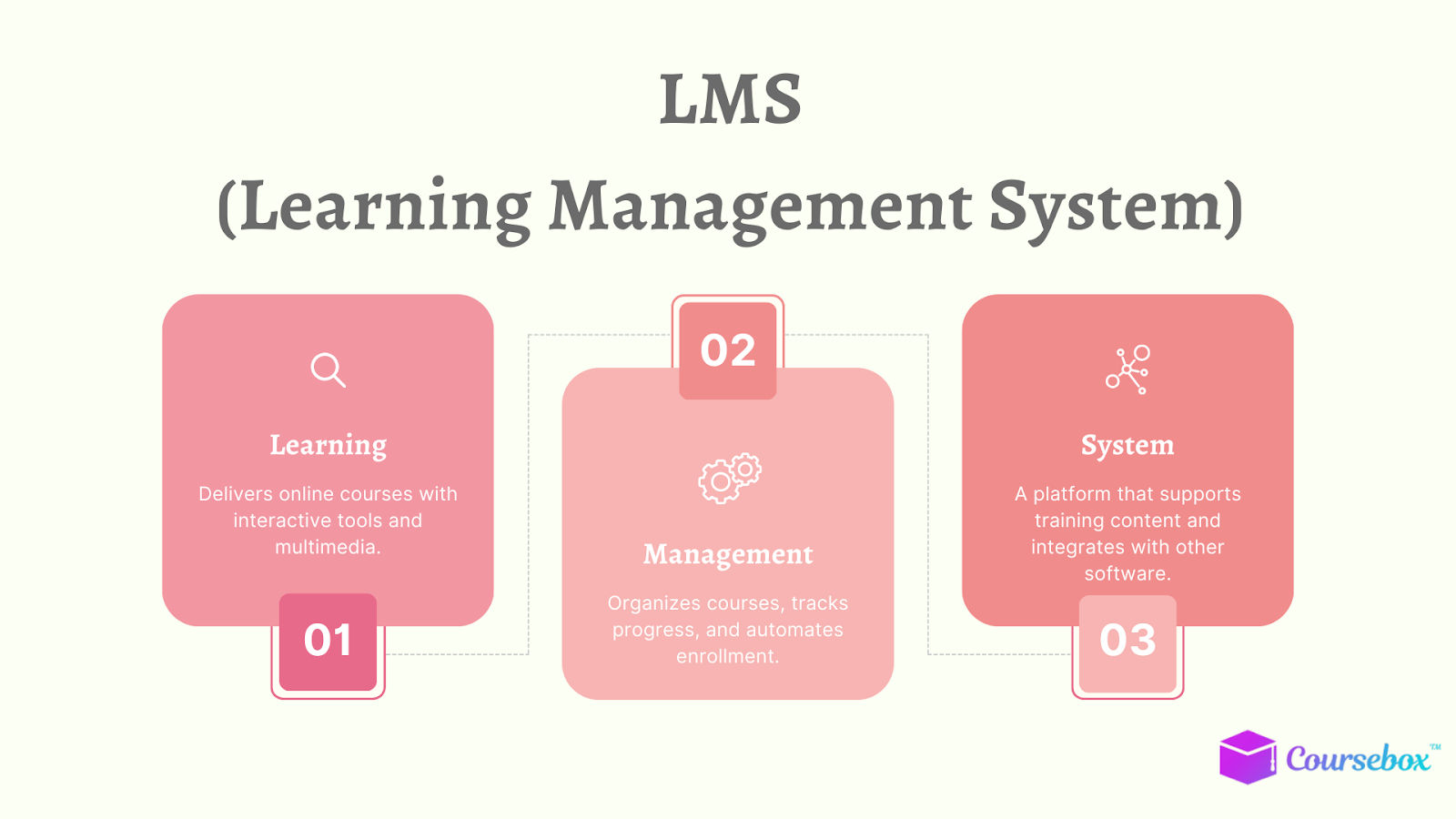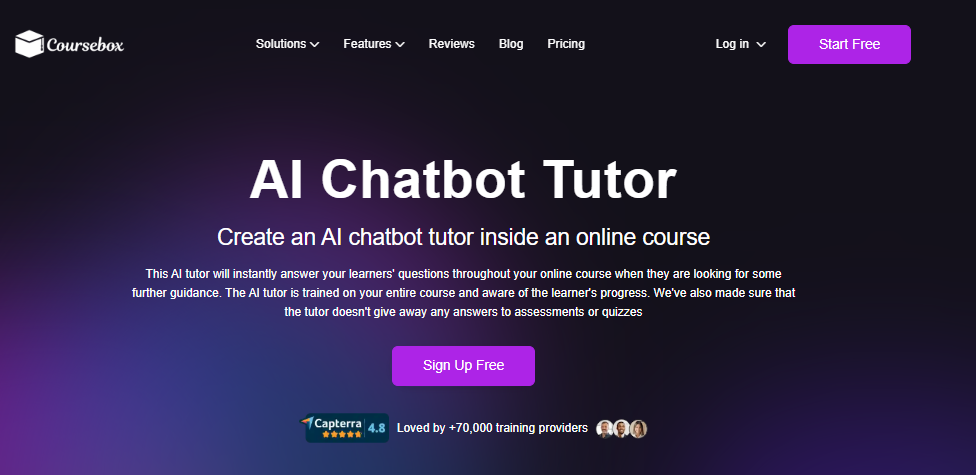The Pros and Cons of Microlearning: A Quick Guide
Microlearning is the future of fast learning, but it’s not perfect. Learn the pros and cons of microlearning to determine if it’s the right choice for you.
Microlearning is the future of fast learning, but it’s not perfect. Learn the pros and cons of microlearning to determine if it’s the right choice for you.

Microlearning provides people with quick, focused lessons on specific tasks or ideas. Think of it like a 3-minute video showing how to fix something or a short presentation on following a rule at work. However, it’s not suitable for every organization.
Studies show that breaking down big topics into small, easy-to-digest bits can make learning more engaging and useful. But before you incorporate microlearning into your training, it’s good to consider the benefits and any downsides to see if it’s the right fit.
The history of microlearning starts with the digital learning methods of the 1990s when people used standalone computers for what was then called Computer-Based Training (CBT).

This later evolved into eLearning, where people could earn degrees and professional certifications online, often through long courses that took months to complete. However, both learners and trainers wanted faster ways to gain knowledge.
By 2005, educational technologist Elliot Masie began talking about “nano learning,” which was the idea that learning should happen in small, quick sessions rather than only during scheduled courses.
Masie described his experience with nano-learning as picking up new skills from a 90-second chat or a brief moment of focus on something new. This concept paved the way for what we now know as microlearning.

Around 2009, educator and HR specialist Josh Bersin coined “microlearning,” signaling a shift from traditional long courses to shorter, more flexible learning experiences.
Microlearning brought in various content formats like articles, videos, and podcasts, making learning more modern and accessible. The rise of smartphones and social platforms also fueled the growth of microlearning.
Suddenly, people could access knowledge instantly through videos or quick articles. Today, microlearning platforms play a key part in how people learn, offering quick, focused lessons that fit into our busy lives.

Microlearning is becoming the favorite training method for many companies, especially since remote work took over the world because it’s flexible and easily digestible. Plus, it uses resources efficiently and many people like it better than old-fashioned training.
Let’s dive deeper into the pros of microlearning.
The reason why microlearning became so popular is because it’s flexible and easily accessible. Learners can get their hands on information whenever they want, wherever they want through videos, podcasts, quizzes, and eLearning infographics.
Additionally, when you share lessons through social media, email, and online videos, you’re using tools people already use. This way, learners can easily access, read, and share the lessons without needing special software.
Microlearning modules can be hosted on learning management systems (LMS) or learning experience platforms (LXP), making it easier for organisations to track completion and engagement.

Smaller lessons take less time than traditional learning methods. They’re also easy to update and send out whenever needed, so learners can get the latest information and changes right away.
Some learners dislike having someone watch their every move, which is why they prefer microlearning. This learning approach lets them take charge of their learning, which can be motivating.
Modern platforms also allow personalised learning journeys. AI-powered systems recommend micro-courses based on a learner’s role, past performance, or skill gaps, making the process more efficient and engaging.
Studies suggest that microlearning helps with remembering information better. Instead of overwhelming the brain with too much data at once, it breaks things down into small, manageable chunks. So, learners can really absorb and remember what they’ve just learned before moving on.
Plus, they get to choose when and where they do the training, so they can pick a quiet time and place that works best for them, like a calm room at home instead of a noisy office.
Microlearning also helps reduce the impact of the Ebbinghaus forgetting curve, which shows how quickly people forget information. Since lessons are spaced and revisited in small bursts, learners are more likely to retain knowledge long term.

Microlearning quickly addresses performance gaps by focusing on one task, skill, or concept at a time. This means learners can fix specific issues faster without needing to go through long training sessions.
For instance, if someone needs to refresh their knowledge on repairing machinery, they can do a quick tutorial to review the steps they need.
Training employees in-house is much cheaper than hiring new staff. Additionally, microlearning cuts training costs and speeds up delivery. In other words, microlearning is cheaper and more efficient than traditional learning methods.
With the help of AI-powered tools like Coursebox, you can create high-quality courses for a fraction of the cost of a full training program. Plus, you can add AI-generated assessments and then let AI grade them for you. Coursebox also has an AI chatbot tutor that answers the learners’ queries in real time.

Microlearning boosts motivation by offering quick wins. While long-term goals matter, short-term successes also play a key role.
When employees complete a brief training module and get what they need right away, they feel more motivated to continue learning. Learning at their own pace means they don’t have to worry about keeping up with others.
Microlearning is also perfect for quick content creation. It fits well with rapid content development that uses templates and tools to speed up training production.
Coursebox enhances this process by helping design course structures and generate content, including quizzes with a user-friendly quiz generator. This allows educators to quickly develop, review, and deliver microlearning modules, making training faster and more efficient.
After seeing the benefits, microlearning might seem like the best thing for learning and development. However, as we said at the very beginning, it’s not perfect.
Here’s a breakdown of some of the cons of microlearning.
Because microlearning involves shorter, quick lessons, some learners might not commit as strongly compared to longer, classroom-based training. They might start lessons and not finish them.
Moreover, microlearning's short bursts of content can make it easy for learners to get distracted or lose focus. To keep learners engaged, focus on their motivation and offer personalized, interesting content.

Microlearning works well for brushing up on basics but may not be enough for teaching new or complex concepts. For these, you might need more time and a formal setting. That being said, you should use short lessons for reminders and simple insights, not for in-depth or certification training.
Another limitation is the difficulty in assessing mastery. While quizzes or short tasks can confirm basic understanding, they may not fully evaluate whether a learner can apply complex knowledge in real-world scenarios.
Microlearning often isn’t the best to teach complicated tasks or skills. These brief lessons work well for quick, focused training, but they might not cover detailed subjects with many related topics.
For example, teaching leadership development, advanced medical procedures, or engineering concepts often requires extended programs. Microlearning can supplement these with scenario-based refreshers but cannot replace structured, long-term training.
Microlearning can be a useful part of a larger training strategy but isn’t usually the best method for achieving long-term goals. It helps employees pick up individual skills or pieces of information, but a single module alone can't achieve long-term objectives.
It works best for immediate needs or specific learning goals, such as mastering a simple task or learning key information.
Since microlearning is often delivered through digital platforms, interactions between learners and instructors can be rare. Additionally, microlearning focuses on delivering information quickly, so educators don’t have many opportunities to assess how well learners understand the material.
Some organisations address this gap by combining microlearning with live coaching sessions or discussion forums, blending quick knowledge delivery with interactive feedback.
Microlearning is great for quick and focused training. It helps with immediate needs and is perfect for short, bite-sized lessons. However, it’s not always the best for deep or complex learning, which requires longer and more detailed sessions.
For thorough learning, traditional macro-learning works better. It offers more depth and structure. Microlearning can complement this by providing additional, easily accessible resources.
In short, microlearning is a useful tool for fast, practical solutions, but it might not replace more in-depth training. To see how microlearning and tools like Coursebox can fit into your training, book a demo today.
Microlearning goes beyond corporate settings. It can be applied in schools, professional development, healthcare, and even personal skill-building.
Most microlearning modules last between 2 and 10 minutes. The goal is to cover one specific idea or skill quickly, without overloading the learner, so that they can understand and retain information easily.
Tools like Coursebox allows trainers to create structured microlearning modules quickly with AI assistance. Instructional designers can use the platform’s AI for generating and grading assessments. Plus, the interactive elements make the microlearning modules engaging for learners.
Use different formats like videos, quizzes, scenario-based questions, role plays, and simulations to keep lessons fresh. Also, personalize the content to match job roles or interests to increase motivation and learner participation.
You can use AI-powered course-building platforms like Coursebox to scale microlearing programs. The tool lets you generate assessments and courses in minutes. Plus, the chatbot tutor lets you expand training without too much manual effort or instructor involvement.
